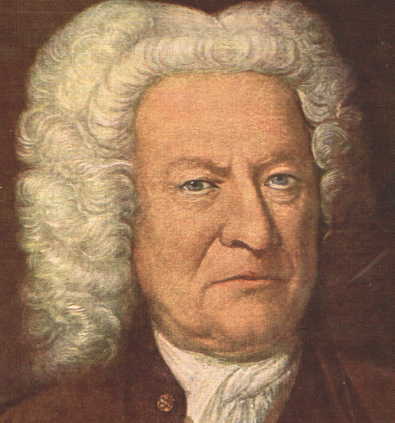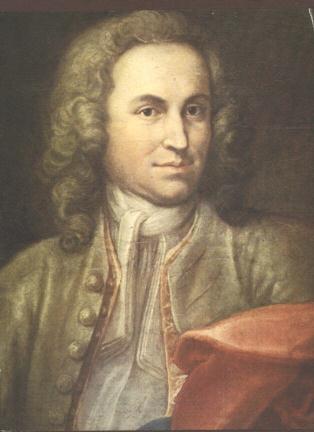|
LEIPZIG 3: 1744-1750 - The Introspective Years
During the latter years of his life Bach gradually withdrew inwards, producing some of the most profound statements of baroque musical form.
In his own much improved apartments of the newly rebuilt Thomasschule Bach would welcome visiting musicians from all over Germany and many other countries. His son Carl-Phillip Emanuel was to write that "no musician of any consequence passing through Leipzig would fail to call upon my father". No doubt they and some of his sons would enjoy a private concert in Bach's large music-room, perhaps featuring concertos for 2, 3 or 4 harpsichords, for Bach kept six claviers and many other instruments.
In 1747, on his way to visit his daughter-in-law in Berlin who was expecting her second child to his son Carl Phillip Emmanuel, Bach stopped at Potsdam after two weary days of traveling. Here he had been invited to attend at the Royal Palace of King Frederick the Great of Prussia, where his son Carl Phillip Emmanuel was also employed as Court Harpsichordist.
On Bach's arrival, Frederick was about to begin his evening concert, in which he himself played the flute with the orchestra, when he was given the list of people who had arrived at Court. Laying down his flute, he said to his orchestra, 'Gentlemen, old Bach is here'. He cancelled his evening concert and invited Bach straight up to try his new fortepianos built by Bach's organ-builder colleague and friend Gottfried Silbermann. The King owned seven of these instruments, located in different rooms. After Bach had played on all the different instruments, moving with the King and musicians from room to room, Bach invited the King to give him a theme on which to improvise; Bach of course rose to the occasion, improvising at length and with amazing skill. On his return to Leipzig, to show his gratitude for the excellent reception he had received at Potsdam, Bach developed the King's theme into a sequence of complex contrapuntal movements, added a sonata for violin and flute (Frederick being a flute-player), entitled the whole 'A Musical Offering' and sent it to the Court with a letter of dedication.
On the day following the musical evening, a royal procession made its way around Potsdam, as Bach was invited to play on all the city's organs.
Bach then became a member (after some persuasion) of the Mitzler society, a learned society devoted to the promotion of musical science, whose members were expected on joining to display some token of their learning. Bach's opening contribution was a set of canonic variations on the Christmas hymn, 'Vom Himmel hoch'.
In these last years of his life, Bach's creative energy was conserved for the highest flights of musical expression: the Mass in b minor, the Canonic Variations, the Goldberg Variations, and of course the Musical Offering displaying the art of canon. His last great work is the complete summary of all his skill in counterpoint and fugue; methods which he perfected, and beyond which no composer has ever been able to pass. This work is known to us as 'Die Kunst der Fuge' ('The Art of the Fugue', BWV 1080).
Bach had overworked in poor light throughout his life, and his eyesight now began to fail him. The Leipzig Council started looking around as early as June 1749 for a successor. On the advice of friends, Bach put himself in the hands of a visiting celebrated English ophthalmic specialist, John Taylor (who also operated on Handel) and who happened to be passing through Leipzig. Two cataract operations were performed on his eyes, in March and Apri1 1750, and their weakening effect was aggravated by a following infection which seriously undermined his health.
He spent the last months of his life in a darkened room, revising his great chorale fantasias (BWV 651-668) with the aid of Altnikol, his son-in-law. It was in these circumstances that he composed his last chorale fantasia, based fittingly on the chorale "Before Thy Throne O Lord I Stand". He was also working on a fugue featuring the subject B-A-C-H (B in German notation is B flat, while H in German notation = B natural). He had often been asked why he had not exploited this theme before, and had indicated that, despite its thematic possibilities, he would consider it arrogant to do so. Appropriately, perhaps intentionally, it was left unfinished at his death. (This incomplete fugue, normally appended to the Art of the Fugue in performances, has no discernible connection with the Art of the Fugue, though the Art of Fugue theme can be made to fit, as Gustav Nottebohm pointed out in 1880.) The last great Triple Fugue of the Art (Contrapunctus XI) may also have been written during his final days.
Then, on the morning of the 28th of July, 1750, he woke up to find he could bear strong light again, and see quite clearly.
That same day he had a stroke, followed by a severe fever. He died 'in the evening, after a quarter to nine, in the sixty-fifth year of his life, yielding up his blessed soul to his savior'.
Bach was buried in St John's Cemetery which stood one block outside the town's Grimma Gate in the early morning of July 31, and in the absence of any tombstone his grave was soon forgotten.
When St John's Church was rebuilt in 1894 a few Leipzig scholars and Bach admirers succeeded in having what were believed to be the composer's bones exhumed. Partial identification was established by a series of anatomical and other tests. The bones were laid to rest in a stone sarcophagus next to the poet Gellert in the vaults of the Johanniskirche, and many people went to pay homage to this tomb until the church was destroyed by bombs in WW2. Once more his remains were rescued and in 1949 buried, this time in the altar-room of the Thomaskirche where they remain to this day.


|








